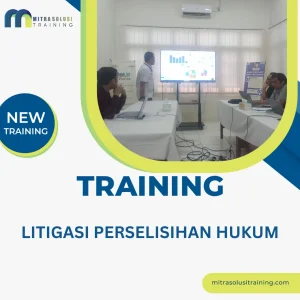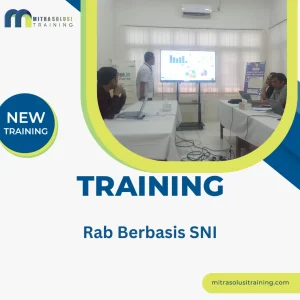TRAINING ACTIVITY BASED COSTING
Table of Contents
ToggleSILABUS TRAINING ACTIVITY BASED COSTING
TRAINING DESCRIPTION TRAINING ACTIVITY BASED COSTING
Materi TRAINING ACTIVITY BASED COSTING
- Shortcomings of traditional cost accounting
- Introduction
- Historical development of cost accounting : A synopsis
- Changes in the business environment since 1940
- Traditional cost systems in the modern environment
- Relevance lost
- Conclusion
- Sources consulted
- Conceptual frame work of an activity – based costing and management system
- Introductio
- Activities
- Resources of cost elements
- Performance measures
- Cost drivers
- Output measures
- Cost objectives
- Bill of activities
- Illustrative frame of an activity – based costing and management system
- Continuous improvement
- Process value analysis and process re-engineering
- Activity investment analysis
- Cost of capital management
- Life – cycle accounting
- Conclusion
- Sources consulted
- Costing methodology for raw materials, products and services
- Introductions
- Methodology
- Nature of costs
- Two – stage allocation process
- Wastage
- Determining the cost of raw materials
- Determining the cost of manufactured products
- Conclusion
- Customer and market profitability
- Strategy shifts
- Customer satisfaction
- Customer and market focus
- Customer as cost object
- Micro – cost structure
- Customer and product analysis
- Tracing of costs to customers
- Profit contribution by customer
- Market profitability
- Conclusions
- Sources consulted
- Income measurement
- Introduction
- Part 1 : The value chain approach
- Phases in the accounting cycle
- Explanation of the model
- Part 2 : Features of an activity – based management system
- Strategic support
- Time based accounting
- Residual income
- Processes
- Life – cycle costing
- Cost drivers and output measures
- Wastage and quality management
- Productivity management
- Capacity management
- Multiple cost focus
- Part 3 : Proposed methodology
- Activity – based management approach
- Conclusion
- Process and activity analysis
- Value of process and activity analysis
- Identifying processes and activities
- Processes and activity analysis methodology
- Process re-engineering
- Conclusion
- Sources consulted
- Cost drivers and output measure analysis
- Introduction
- Cost behaviour
- Two – stage cost drivers
- Process drivers
- Output measures
- Focus on output
- Number of output measures (and activities)
- Identification of output measures
- Simple linear regression
- Multiple linear regression
- Validation of output measures
- Conclusion
- Sources consulted
- Cost management
- Introduction
- Strategies analysis
- Processes and activity analysis
- Continuous cost improvement
- Performance evaluation
- Capacity management
- Quality management
- Productivity management
- Process and cycle time
- Conclusion
- Sources consulted
- Activity – based budgeting
- Introduction
- Steps in the ABB process
- Differences between ABB and conventional budgeting
- Controlling through activities
- Conclusion
- Sources consulted
- Performance measurement
- Effectual measures
- Role of activity – based management within a performance measurement system
- The design of a performance measurement system
- Goals and objectives in respect of performance measures
- Characteristics of performance measures
- The balance scorecard
- Conclusion
- Sources consulted
- Implementation
- Introduction
- Step to implement ABC & M
- Systems design and computerisation issues
- Stand – alone or integrated system
- Level of confidence in costs
- Applicability of activity – based cost and management systems
- Links with other management systems
- Conclusion
- Sources consulted
- Strategy support
- Interactive relationship
- Beneficial characteristics of ABC & M
- Strategic applications
- Conclusion
- Sources consulted
Metode TRAINING ACTIVITY BASED COSTING
Metode Training activity based costing dapat menggunakan fasilitas training zoom atau training online, dan bisa juga training offline atau training tatap muka.
Instruktur TRAINING ACTIVITY BASED COSTING
Instruktur yang mengajar pelatihan activity based costing ini adalah instruktur yang berkompeten di bidang activity based costing baik dari kalangan akademisi maupun praktisi.
Peserta TRAINING ACTIVITY BASED COSTING
Peserta yang dapat mengikuti training activity based costing ini adalah staff sdm atau karyawan yang ingin mendalami bidang activity based costing.
Jadwal Pelatihan Mitra Solusi Training Tahun 2025 :
Batch 1 : 15 – 16 Januari 2025
Batch 2 : 12 – 13 Februari 2025
Batch 3 : 05 – 06 Maret 2025
Batch 4 : 16 – 17 April 2025
Batch 5 : 14 – 15 Mei 2025
Batch 6 : 11 – 12 Juni 2025
Batch 7 : 02 – 03 Juli 2025 || 23 – 24 Juli 2025
Batch 8 : 13 – 14 Agustus 2025
Batch 9 : 03 – 04 September 2025 || 24 – 25 September 2025
Batch 10 : 15 – 16 Oktober 2025
Batch 11 : 05 – 06 November 2025 || 26 – 27 November 2025
Batch 12 : 10 – 11 Desember 2025
Jadwal tersebut dapat disesuaikan dengan kebutuhan calon peserta
Lokasi Training Tahun 2025 :
- Yogyakarta, Hotel Dafam Seturan(7.300.000 IDR / participant)
- Jakarta, Hotel Amaris Tendean (7.900.000 IDR / participant)
- Bandung, Hotel Golden Flower (7.800.000 IDR / participant)
- Bali, Hotel Ibis Kuta (8.500.000 IDR / participant)
- Lombok, Hotel Jayakarta (8.750.000 IDR / participant)
Catatan :
- Waktu pelatihan Dua+1* hari dengan Biaya tersedia untuk Perorangan, Group, dan Inhouse Training, belum termasuk akomodasi/penginapan.
- Untuk biaya dan jadwal training harap menghubungi marketing kembali
Investasi training:
Investasi pelatihan selama dua hari tersebut menyesuaikan dengan jumlah peserta (on call). *Please feel free to contact us.
Apabila perusahaan membutuhkan paket in house training, anggaran investasi pelatihan dapat menyesuaikan dengan anggaran perusahaan.
Fasilitas training:
- Free Penjemputan dari bandara ke hotel*.
- Modul / Handout.
- Flashdisk*.
- Certificate of attendance.
- FREE Bag or bagpacker.














